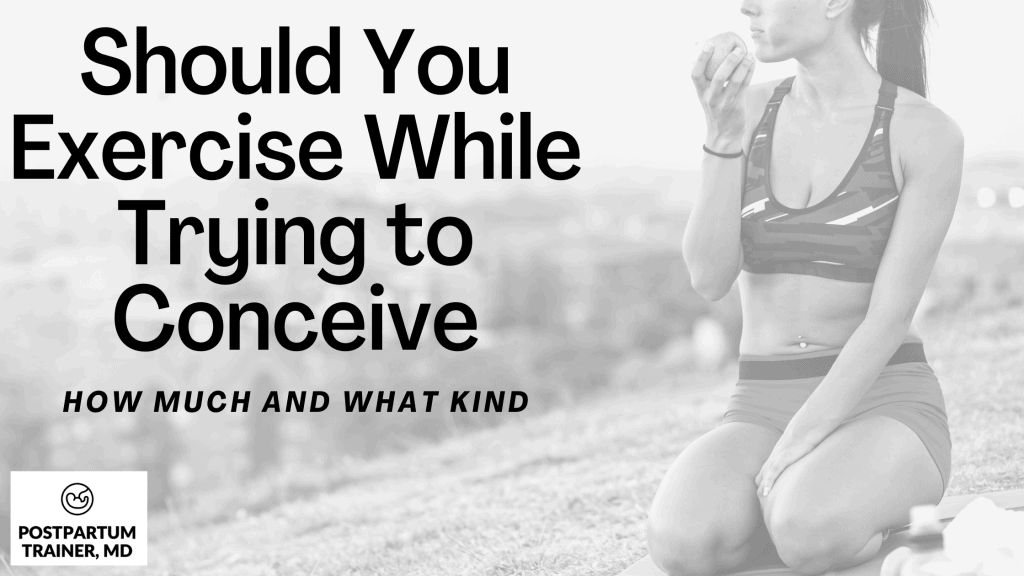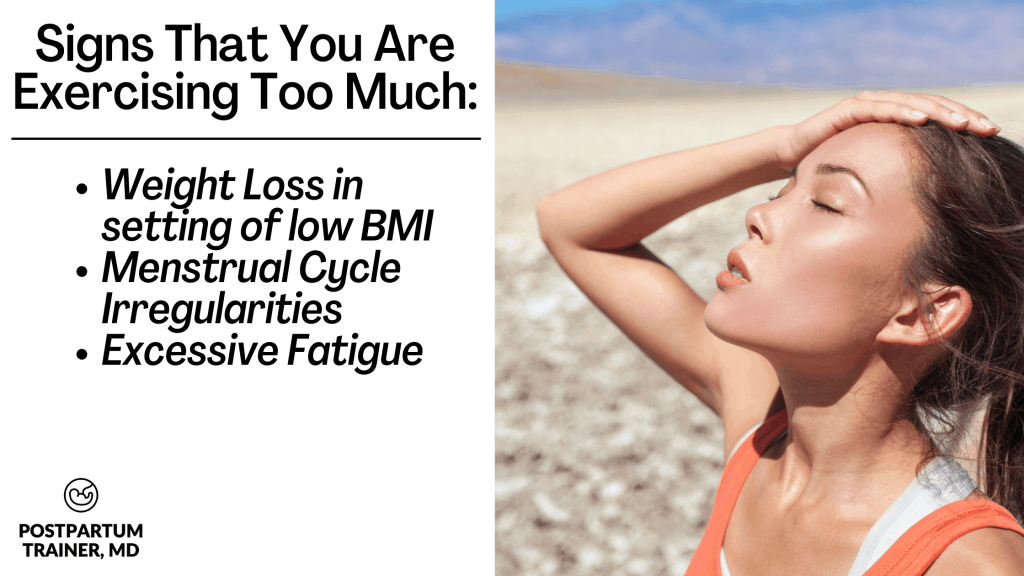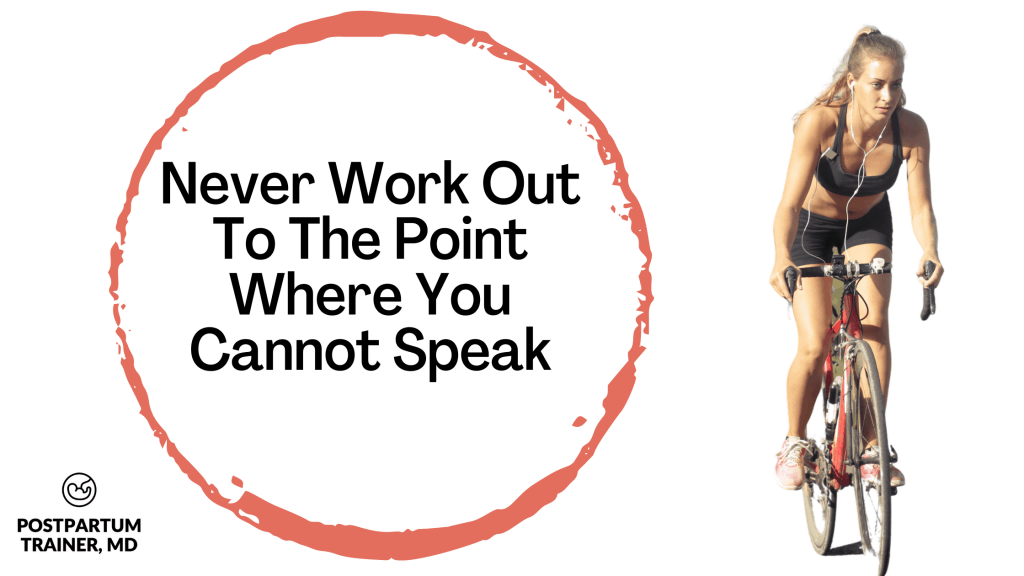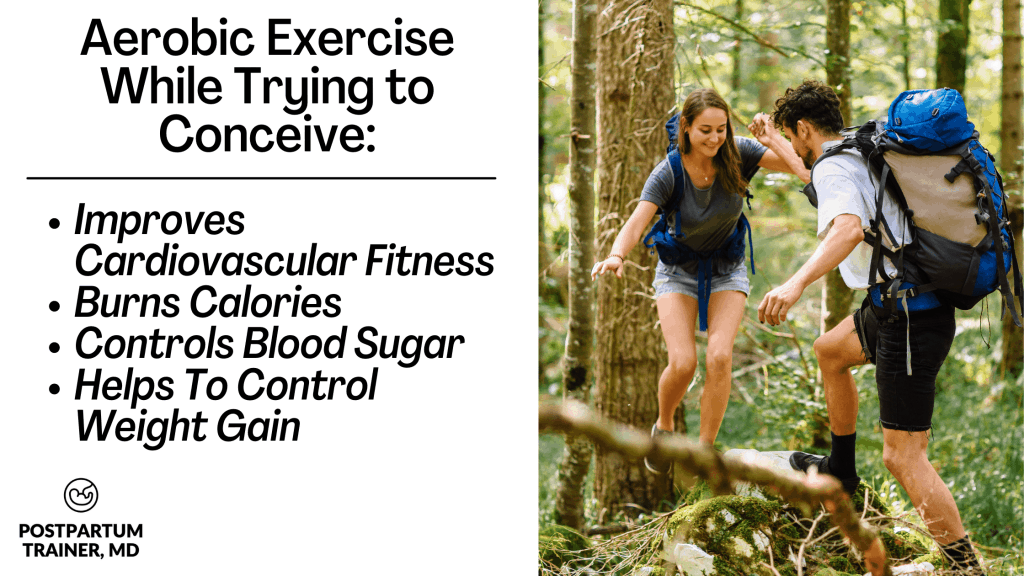Are you wondering if you should exercise while trying to conceive?
You’re in the right place!
In today’s post, my husband Dr. Alex Robles who is a Reproductive Endocrinologist will be joining me to answer all your questions regarding exercise and fertility.
We will answer questions like:
- Does exercise affect implantation.
- The best exercises for fertility, and
- What can help you get pregnant faster.
Let’s get started!

Is it safe to exercise while trying to conceive?
Not only is it safe to exercise while trying to conceive, but it can also be beneficial for fertility.
That’s because regular exercise can reduce your risk of obesity, metabolic disease, and improve your cardiovascular health. All of these things can:
- help you get pregnant, and
- reduce your risk of pregnancy related complications
This recommendation also holds true for pregnant women!
You should limit vigorous exercise and instead opt for moderate-intensity exercise.
The most important thing to focus on is trying to maintain a normal body mass index (BMI) before attempting pregnancy.
An abnormally high BMI can be associated with infertility, pregnancy complications, and an increased risk of neonatal congenital malformations.
With that said, too much exercise isn’t good either.
How much should you exercise when trying to conceive?
When trying to conceive, you should try to exercise 30 minutes a day, ~5 days a week with moderate activity.
With that said, your exercise routine will depend on your activity levels prior to becoming pregnant.
If you have never exercised before, I recommend that you start slow and work your way up in intensity.
If you are a competitive athlete, with a vigorous training routine- you may actually have to decrease the intensity of your workouts. This isn’t the time to try and set maximum effort personal records.
Let’s talk about how much is too much.
How much is too much exercise?
Your body is amazing at non-verbal communication. Signs that you are exercising too much while trying to conceive are:
- weight loss in the setting of a low BMI (<18.5)
- menstrual cycle irregularities
- excessive fatigue from strenuous exercise routines
Let’s go over each one in more detail.

Warning Sign #1: Weight Loss In The Setting of A Low BMI
Weight loss is due to one of two things- decreased caloric intake or excessive energy expenditure. Sometimes both.
Your body sees this as a highly stressful event that can lead to alterations in many hormones that control your metabolism.
Think about it. Fat is stored energy. Your body doesn’t want to burn fat unless it has to.
It will only do so if it is forced to such as during a time of food scarcity.
Low caloric intake with frequent exercise leading to weight loss (in someone with a low BMI) will be interpreted as a metabolic emergency.
As such, your body will not waste resources on “non-essential” processes such as reproduction.
This is called hypothalamic amenorrhea.
Warning Sign #2: Irregular Menstrual Cycles
Not menstruating in the setting of regular high intensity exercise is a sign of too much exercise.
This is commonly seen in competitive female athletes, particularly in those with a low body mass index <18.5.
However, it can also happen at a higher BMI as well.
This condition of hypothalamic amenorrhea is associated with a triad of symptoms.
The female athlete triad consists of amenorrhea (aka you are not ovulating and do not get periods) disordered eating, and osteoporosis or weakened bones.
This is a serious condition and requires prompt evaluation.
Why Do You Stop Getting Periods?
Hypothalamic amenorrhea is seen during a period of low energy (due to poor caloric intake and/or excessive energy expenditure). As such, your body has to divert resources away from non-essential processes in order to maintain essential processes (like breathing, maintaining your blood pressure etc).
As a result, your hypothalamus will stop producing a hormone known as gonadotropin releasing hormone (GnrH) which is necessary to produce two other hormones: FSH and LH.
These are responsible for follicle growth in your ovaries.
As such, you will never produce a follicle big enough to ovulate, which is what is necessary to be in the luteal phase of the menstrual cycle. The ending of the luteal phase is what ultimately triggers menstruation 2 weeks after ovulating.
How To Ensure You Aren’t Doing Too Much
To help ensure that you aren’t exercising too vigorously, you should use a rate of perceived exertion.
It is when you rate your workout on a scale of 1-10, with 1 being minimal effort and 10 being maximal exertion.
When trying to conceive, I recommend that you do not exceed a 7.
A simple way to track this is to see if you are able to hold a very basic conversation with 3 word sentences.

Never work to the point where you cannot speak.
Also, it’s a good idea to not let your heart rate approach your maximum heart rate (which can be calculated by 220 – your age).
Now let’s go over what type of exercises you can do.
Can I lose weight while trying to conceive?
If you are overweight or obese (BMI >25), it is recommended that you lose weight prior to getting pregnant.
Lowering your body fat has several benefits for both fertility and pregnancy.
This is especially true if you happen to have Polycystic Ovarian Syndrome (PCOS) and you don’t get periods.
Studies confirm that even a modest 5% weight loss can help restore menstrual cycle regularity and improve fertility.
The best way to lose weight is through a combination of a healthy diet and moderate physical activity.
Which exercise is best for fertility?
Prior to engaging in any sort of exercise, it is important that you first speak with your healthcare provider to ensure you are cleared to workout.
If you are cleared, let’s get started.
Here is a list of the best exercises to perform when trying to conceive.
Lifting weights while TTC
Lifting weights is a great form of exercise that you can do when trying to conceive (TTC). The goal of lifting weights is to build strength and develop lean muscle tissue.
In addition, it can strengthen your bones and decrease your risk of osteoporosis.
With all exercise, it is best to start low and go slow especially if you have never done any form of strength training.
Be sure not to overdo it.
To learn more about lifting weights, check out my article on weightlifting postpartum that will also be helpful to you in the pre-pregnancy state.
Running while TTC
The next exercise that is great for your health is running.
Running helps to improve your cardiovascular fitness, strengthens the muscles in your lower body, and helps promote circulation.
If you are a beginner, start slow and do not overexert yourself.
Always maintain proper hydration!
For your convenience, I have an entire article explaining how to start running that you could check out here.
Other aerobic exercise
If you don’t like running, you can do other aerobic exercises that include:
- Cycling
- Hiking
- Swimming
- Elliptical trainer
- Rowing
These are great exercises to perform as they are very dynamic and allow you to get a great full body workout.
Like running, these exercises help to improve your cardiovascular fitness, burn calories, control blood sugar, and help to control your weight.
Always make sure to have water with you to keep yourself hydrated and be sure to wear breathable clothing.

Pilates/Yoga
The last exercises we will discuss are pilates and yoga.
Pilates is a type of workout designed to stretch and strengthen your entire body. This can be great for strengthening the muscles of your core and pelvic floor.
Yoga is a mind body practice that allows you to combine breathing and meditation techniques while holding various postural positions to strengthen the muscles in your body.
These are great practices to help ground you especially if you are experiencing high stress levels.
As always, I would recommend you go at your own pace when first starting out.
Also, avoid hot yoga as hyperthermia can potentially cause fertility problems.
Other Related Questions
What about exercise and fertility in men?
There isn’t a lot of compelling research showing an association between exercise and male fertility.
The participants had their semen volume, sperm concentration (aka sperm count), sperm motility, sperm morphology, and total motile sperm count analyzed.
They found no overall association, however, they did see a lower sperm count and motility in men who cycled more than 5 hours per week.
This is consistent with other studies that found sperm quality can be impacted by regular cycling.
So if a couple is having difficulty conceiving, it is a good idea for the male to minimize any cycling around the time of sperm production.
Can I exercise during ovulation?
Exercise during ovulation is safe, however, you should be aware of some symptoms you may experience when ovulating so as to not be alarmed.
Typically when you ovulate, your basal body temperature will drop slightly and then rise again.
You may experience some discomfort or cramping in either the right or left side of your lower abdomen depending on what ovary you are ovulating from.
You may also notice increased discharge from the vagina that is clear and thin.
Does exercise affect implantation?
As far as we know, exercise does not affect implantation.
If you do not know, implantation is the stage of pregnancy in which the embryo, now known as the blastocyst, attaches to the endometrial wall of the uterus to begin growing.
What can help me get pregnant faster?
There are several things you could do to increase your chances of getting pregnant.
First and foremost, you should avoid any toxic habits.
This includes things like smoking, illicit drug use, and excessive drinking.
Next, you should maintain a healthy weight through a combination of a healthy diet and regular physical activity (while avoiding excessive exercise.)
There are several smartphone applications that you could download to do this for you.
You could also use ovulation predictor kits to help predict the most optimal days to have unprotected intercourse.
Final Words on Exercise & Fertility
Exercise is a great way to help maintain a healthy lifestyle pre-pregnancy.
It is also a key step in maintaining a healthy pregnancy as well!
If you are TTC, it’s a good idea to have a preconception visit with your obstetrician-gynecologist, especially if you have any medical conditions.
This way your doctor could give you personalized recommendations on your exercise regimen.
Also, be sure to take a prenatal vitamin with folic acid for at least 12 weeks prior to TTC!
Now I want to hear from you.
Are you TTC and exercising?
What type of exercise are you doing?
Comment below and let me know!

Alex Robles, MD is a reproductive endocrinology fellow at Columbia University Medical Center in New York and a Certified Personal Trainer. He completed his OBGYN residency at Weill Cornell Medical Center. Learn more about fertility at Alexroblesmd.com
Get Four Free Workouts To Help Strengthen Your Pelvic Floor & Heal Your Mommy Tummy!

Brittany Robles, MD, MPH, CPT
Brittany Robles is a full-time OBGYN physician, a NASM certified trainer, and a prenatal and postnatal fitness specialist. She holds a Master of Public Health degree in maternal health with a special interest in exercise and nutrition. She is also the co-author of The White Coat Trainer. Learn more about her here.
Sharing is Caring – Send This To A Mom In Need!
References:
- Dağ ZÖ, Dilbaz B. Impact of obesity on infertility in women. J Turk Ger Gynecol Assoc. 2015;16(2):111-117. Published 2015 Jun 1. doi:10.5152/jtgga.2015.15232
- Persson M, Cnattingius S, Villamor E, et al. Risk of major congenital malformations in relation to maternal overweight and obesity severity: cohort study of 1.2 million singletons. BMJ. 2017;357:j2563. Published 2017 Jun 14. doi:10.1136/bmj.j2563
- Mena GP, Mielke GI, Brown WJ. The effect of physical activity on reproductive health outcomes in young women: a systematic review and meta-analysis. Hum Reprod Update. 2019;25(5):541-563. doi:10.1093/humupd/dmz013
- Best D, Avenell A, Bhattacharya S. How effective are weight-loss interventions for improving fertility in women and men who are overweight or obese? A systematic review and meta-analysis of the evidence. Hum Reprod Update. 2017;23(6):681-705. doi:10.1093/humupd/dmx027
- Kiddy DS, Hamilton-Fairley D, Bush A, et al. Improvement in endocrine and ovarian function during dietary treatment of obese women with polycystic ovary syndrome. Clin Endocrinol (Oxf). 1992;36(1):105-111. doi:10.1111/j.1365-2265.1992.tb02909.
- Wise LA, Cramer DW, Hornstein MD, Ashby RK, Missmer SA. Physical activity and semen quality among men attending an infertility clinic. Fertil Steril. 2011;95(3):1025-1030. doi:10.1016/j.fertnstert.2010.11.006
- Hajizadeh Maleki B, Tartibian B. Long-term Low-to-Intensive Cycling Training: Impact on Semen Parameters and Seminal Cytokines. Clin J Sport Med. 2015;25(6):535-540. doi:10.1097/JSM.0000000000000122
